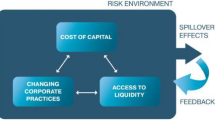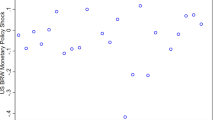Abstract—
The article presents the results of research using the DSGE model, which includes such sectors of the economy as real sector enterprises, households, financial intermediaries, and the monetary regulator. In turn, the household sector is represented by groups of savers and borrowers. Financial intermediaries transform temporarily idle funds of households into loans to enterprises of the real sector, and financial wedges can arise in this link preventing the flow of capital. In the manufacturing sector, there are extractive industries for which the production level is set exogenously in order to adequately reflect the impact of the OPEC+ agreement. A feature of the proposed model is a firm-specific capital approach, which assumes that the owners of the fixed capital are the firms that make investment decisions. In our opinion, this little-studied class of DSGE models is more relevant to the Russian realities than traditional general equilibrium models.





Similar content being viewed by others
Notes
Formally, we use a nested production function \({{Y}_{{H,t}}} = \min \left\{ {{{A}_{t}}K_{t}^{\alpha }L_{{H,t}}^{{1 - \alpha }};\frac{1}{{ee}}E{{E}_{t}}} \right\}\), where \(E{{E}_{t}}\) is the internal energy consumption, and ee is the energy-output ratio. It is well known that the equilibrium condition for the manufacturer using the production technology with complementary factors (Leontief production function) is the minimum amount of costs for each of the complementary factors of production. That is, the manufacturer’s optimum is \({{Y}_{{H,t}}} = {{A}_{t}}K_{t}^{\alpha }L_{{H,t}}^{{1 - \alpha }} = \frac{1}{{ee}}E{{E}_{t}}\).The first equality is the usual Cobb–Douglas function, a variant of which is represented in deviations by 0. The second equation relates internal (intermediate) consumption of energy resources to production activity in nonextractive branches of the economy.
REFERENCES
D. N. Shul’ts and V. I. Baluta, Preprint No. 44, IPM im. M.V. Keldysha (Keldysh Institute of Applied Mathematics, Moscow, 2021). https://doi.org/10.20948/prepr-2021-44
V. I. Baluta and D. N. Shults, “A version of a dynamic stochastic general equilibrium model for an open economy,” Math. Models Comput. Simul. 12, 519–527 (2020).
D. N. Shul’ts and V. I. Baluta, “Bayesian estimation of a dynamic stochastic general equilibrium model,” Ekon. Predprinimatel’stvo, No. 2 (115), 290–295 (2020).
D. Altig, L. J. Christiano, M. Eichenbaum, and J. Linde, Firm-Specific Capital, Nominal Rigidities and the Business Cycle, National Bureau of Economic Research, Working Paper 11034, 2005. https://www. nber.org/papers/w11034.pdf.
G. Walque, F. Smets, and R. Wouters, Firm-Specific Production Factors in a DSGE Model with Taylor Price Setting: Working Paper No. 648 (European Central Bank, Frankfurt, 2006). https://www.econstor.eu/bitstream/10419/153082/1/ecbwp0648.pdf.
M. Woodford, “Firm-specific capital and the new Keynesian Phillips curve,” Int. J. Cent. Bank, No. 2, 1–46 (2005).
O. I. Dranko, “Capital intensity of activities of the Russian economy,” Audit Finansovyi Anal., No. 3, 67–70 (2015). https://www.auditfin.com/fin/2015/3/ fin_2015_31_rus_03_02.pdf.
A. V. Polbin, Candidate’s Dissertation in Economics (Moscow, 2015) [in Russian].
D. N. Shul’ts, “Behavioral economics and dynamic general equilibrium models,” Vopr. Ekon., No. 1, 47–65 (2020). https://doi.org/10,32609/0042-8736-2020-1-47-65
Most Russian families ended up with no savings capital at all. https://www.rbc.ru/economics/16/05/2019/ 5cdabe099a79479536f3c523.
Most Russians found themselves without savings capital during the crisis. https://www.rbc.ru/economics/31/03/2020/5e7dd7c59a7947c7f63c1e66.
M. Andreyev, Adding a fiscal rule into a DSGE model: How much does it change the forecasts? Working paper series no. 64, Bank of Russia, 2020. https://cbr.ru/StaticHtml/File/117488/wp-64_e.pdf.
D. Kreptsev and S. Seleznev, “Forecasting the Russian economy using DSGE models with a small number of equations,” Den’gi Kredit 77 (2), 51–67 (2018).
A. Novak and A. Shul’gin, Monetary Policy in an Economy with Regional Heterogeneity: Approaches Based on Aggregated and Regional Information (Central Bank of the Russian Federation, Moscow, 20). https://cbr.ru/ Content/Document/File/108035/wp_2003.pdf.
A. V. Bozhechkova and A. V. Polbin, “Testing the presence of an interest rate channel in the IP curve for the Russian economy,” Ekon. Politika 13 (1), 70–91 (2018).
Bank of Russia, About inflation. http://www. cbr.ru/dkp/about_inflation/.
ACKNOWLEDGMENTS
We are grateful to E. Vikhareva, A. Polbin, A. Votinov, and R. Demikhov for valuable comments and suggestions.
Funding
This work was supported by the Russian Science Foundation, project no. 21-78-10134 (https://rscf.ru/project/21-78-10134/).
Author information
Authors and Affiliations
Corresponding author
Ethics declarations
The authors declare that they have no conflicts of interest.
Additional information
Translated by O. Pismenov
Rights and permissions
About this article
Cite this article
Baluta, V.I., Shul’ts, D.N. & Lavrinenko, P.A. Assessing the Impact of Global Hydrocarbon Prices on the Russian Economy Based on the DSGE Model with Capital-Owning Firms. Stud. Russ. Econ. Dev. 33, 107–117 (2022). https://doi.org/10.1134/S1075700722010038
Received:
Revised:
Accepted:
Published:
Issue Date:
DOI: https://doi.org/10.1134/S1075700722010038




